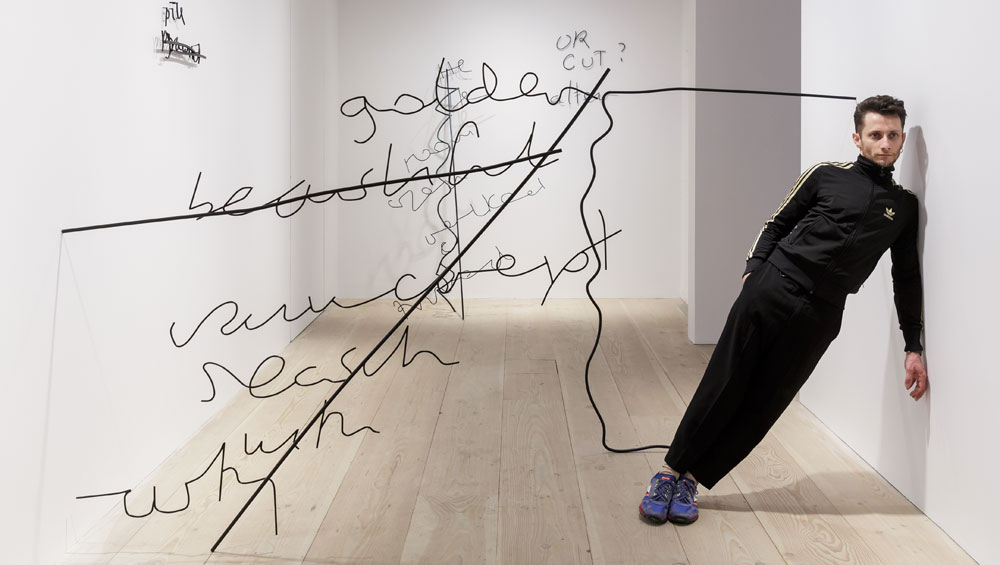
by IZABELLA SCOTT
Alex Mirutziu (b1981, Romania) is a sculptor, poet and performance artist. In his first solo exhibition in the UK, Between Too Soon and Too Late, shown at the Delfina Foundation in London, he examined the life and work of the writer Iris Murdoch (1919-99). Visiting Murdoch’s archive at Kingston University, Mirutziu looked at the work the author made in the final 20 years of her life, when she had Alzheimer’s disease. He gave attention to errors, cuts and repetitions found in Murdoch’s notebooks, and transposed the markings into sculpture, video work and performance.
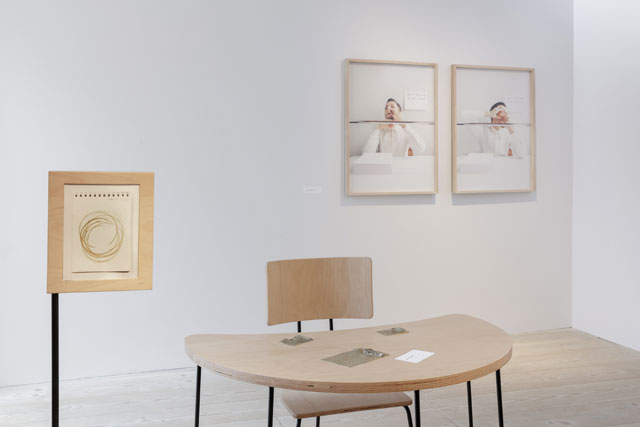
Alex Mirutziu, Between too soon and too late, 2018. Installation view, Delfina Foundation, London. Photograph: Tim Bowditch. Courtesy Delfina Foundation and European ArtEast Foundation.
I meet Mirutziu on a stormy day in June at the Delfina Foundation. He is a slight man with arctic-blue eyes, in a tailored tweed jacket and DayGlo socks. After suggesting that we sit on the gallery floor, he produces a pair of white cushions from a cupboard and perches among his sculptures. I follow suit and, as lightening flashes outside, we discuss the biomechanics of writing, necrophilia and Iris Murdoch’s teddy bear.
Izabella Scott: We are sitting in a corridor of the gallery, taken over by your sculptures. They take the form of scribbles and crossed-out words, made of black wire. Why are you taking broken sentences and making them concrete?
Alex Mirutziu: I’m interested in error, misunderstanding, correction – and all these sculptures show an error of sorts. For some time now, I’ve been making work around the life of the British writer and philosopher Iris Murdoch. As part of my residency at Delfina Foundation in London, I visited her archive at Kingston University. I’ve been looking at the last period of her life, when she had Alzheimer’s disease, which she was diagnosed with in the 1990s, but which had been brewing for some time before that. Looking at Iris’s archive, and particularly the errors and mistakes in her later work, I wanted to take some of the erratum, and reverse the idea of these thing being left out – and instead to put emphasis on them, to make them so big that you can’t help but encounter them.
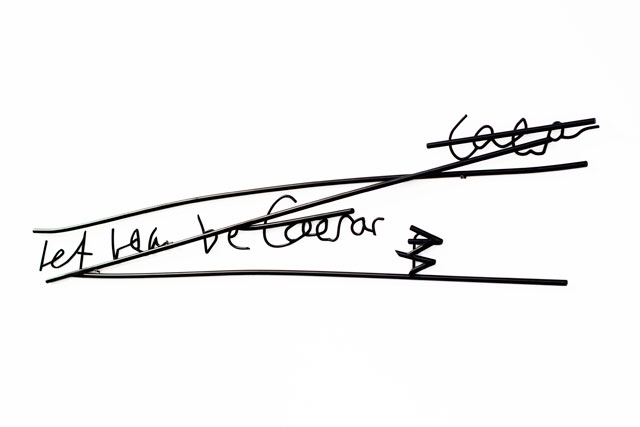
Alex Mirutziu. Let him be Caesar, 2018. Iron, 130 x 37 cm. Courtesy the artist.
IS: Are these marginalia, or edits she made herself?
AM: They are tiny marks that she made on to her writing. The archive at Kingston includes diaries, poems that haven’t been published, 3,000 letters, postcards and a lot of notebooks. Many of these papers were taken from Iris’s house in Oxford, and there are some objects, too, such as a teddy bear that Iris is said to have held in her arms when she died. There are also books taken from Iris’s house, which have notations in them. Iris was unusual, because she established herself as a philosopher and a novelist in the 60s. The Kingston archive contains philosophical books rather than novels – treatises on logic and ethics – and you can see her markings on the pages.
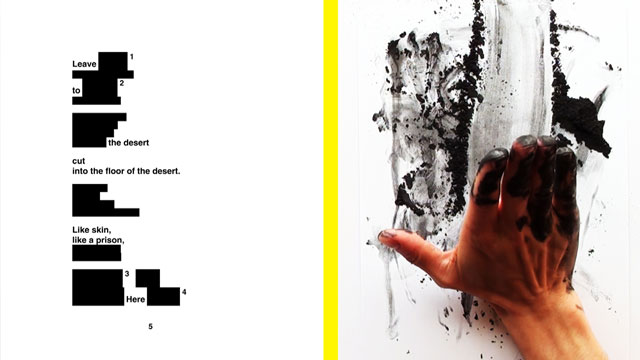
Alex Mirutzu. Where is the poem, 2013-. HD video 9 min 49 sec, and framed C-prints. Courtesy the artist.
IS: Often, writers and biographers want to connect with their subject via certain significant objects – and you mentioned Murdoch’s teddy bear. For example, the writer Wayne Koestenbaum, who wrote a biography of Andy Warhol, tried on Warhol’s corset. Are you looking for some kind of transference – intimacy?
AM: Visiting the archive and seeing Iris’s objects was a new experience for me and I felt something that I can only describe as uncanny. Prior to this, I was experiencing what Iris wrote at a distance – in republished books, say, or pdfs. Then I went into the archive. It was overwhelming. You touch something that she has touched. Between the pages, sometimes I would find a hair. Who knows if it’s hers? You see the coffee stains, and it’s emotional. There is a feeling of being close to her – maybe too close to her – and this was another thing that I felt. Was I interfering too much? Would Iris have wanted this? Going into the archive is a kind of necrophilia, to go where you shouldn’t go, and there is always an ethical question that must be grappled with. I have often thought that Iris would not have liked to be seen in this way, for her errors to take centre stage. After all, the back cover of her complete letters [Living on Paper: Letters from Iris Murdoch, 1934-95] has the instruction, “Destroy this and all letters. And keep your mouth shut”, which is taken from one of her letters.
IS: Pure objectivity is probably impossible when writing about another life, and in that sense there is always a gap between biographer and subject – there is always a betrayal, no matter how true you might want to be. But in this case, you seem to have a strong inkling that Murdoch would have disliked the focus on her errors, on her Alzheimer’s, and on her decline. So why do it?
AM: She was on my mind; I felt connected to her. And because Iris fell between the cracks. I went in carefully – cautiously. My entry point to Iris was her philosophy. I was on a residency in Ireland in 2016, at Cow House Studios. The project was called The Centre for Dying on Stage, and we were looking at artists or creatives who had died on stage. There are numerous cases – a conductor who had a heart attack, for example. I was interested in the theme tangentially, because my work is often concerned with death, addiction, passion, or artists that consume themselves in their lifetime. I was a little anxious during this residency – lonely and disconnected – and I began to think about Iris Murdoch. It was an incubation period for the work to come.
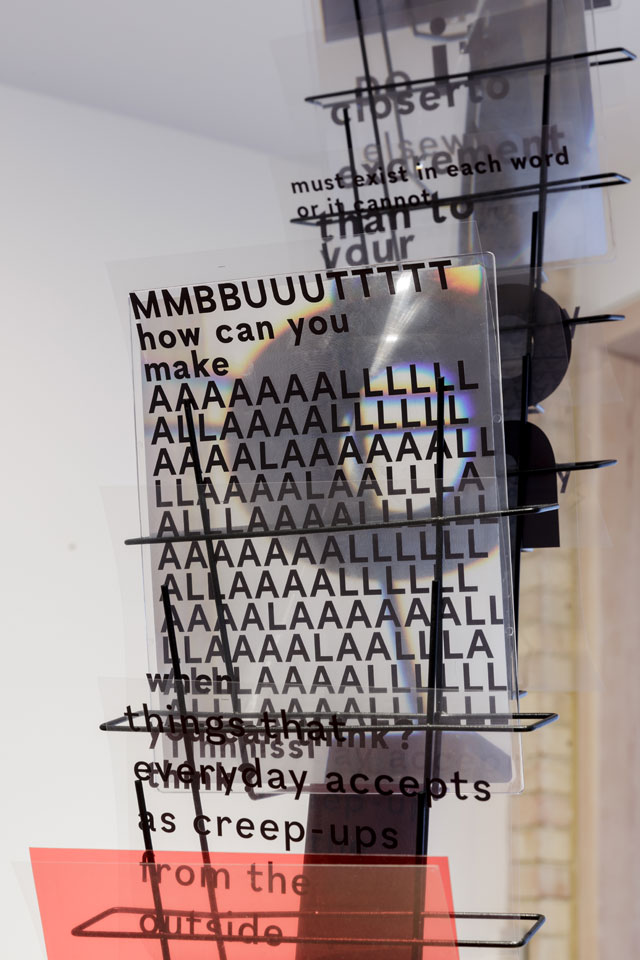
Alex Mirutziu, Between too soon and too late, 2018. Installation view, Delfina Foundation, London. Photograph: Tim Bowditch. Courtesy Delfina Foundation and European ArtEast Foundation.
IS: Murdoch became widely known for her novels, and I’m much less familiar with her philosophy. What parts of her thinking do you find so engaging?
AM: Iris theorised the inner life: what happens philosophically within, the intellectual movement inside in your head. She talks of the “tiny space” where meaning stays unspoken, immaterial – and the works in this show try to occupy this tiny space, to prolong the process of establishing meaning. I’m also interested in Iris’s concept of “goodness”. She wanted to be “good” – but not in a moral sense, but “good” being a way of getting as close to your intentions as possible. To be true to your work. To be faithful to what you beliefs are. To follow it. I found that to be really important to the way I think. But I also read many of her novels, too, which also explore inner life – in this case, the interior worlds of her protagonists, the complexity of the mind. I find her transgressive in the way that she wrote about relationships between men and woman, especially gay relationships. It’s very unusual for the 1960s. She often spoke of her writing process, establishing a situation with two or three characters, and then letting the novel develop out of that. She sets the stage and the rules, and then the action happens. In some sense, the characters being to emerge independently, as if they have a will of their own, as if the writer is collaborating with the characters.
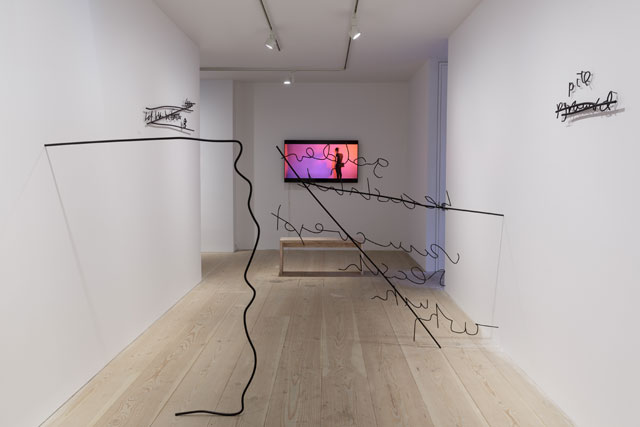
Alex Mirutziu, Between too soon and too late, 2018. Installation view, Delfina Foundation, London. Photograph: Tim Bowditch. Courtesy Delfina Foundation and European ArtEast Foundation.
IS: Murdoch’s first novel, Under the Net (1954) is about language. In the novel, she stages characters who are trying to express themselves, but who get caught in the net of language. Are you thinking of the mental deterioration of Alzheimer’s disease in linguistic terms? You seem to want to show Murdoch getting caught up in her own net.
AM: Iris was diagnosed with Alzheimer’s in 1995, when she was 76 years old. But she actually had symptoms that dated from more than 25 years earlier. You can read it in her letters: she felt that something wrong. She wrote many times that she felt tired, that writing was hard – and this goes right back to the 1970s. She is at the peak of her career. In 1978, her novel The Sea, The Seawon the Booker Prize – but already she can feel the decline. Looking back, it’s obvious that it began early on. This sculpture in front of us, Continue or abandon? (2018), is taken directly from her notebook. In them, she wrote cuts on the left margin, and notations on the right. I pulled out the words that felt significant.

Alex Mirutziu. How to draw with the fact of mind, 2014-. Chromogenic print, 90 x 67.5 cm. Courtesy the artist.
IS: Is there a sense that, retrospectively, you can find meaning where there is none? That your eyes in the future take something else from her past?
AM: Yes – and sometimes it isn’t fair. But I think the corrections, errors and inserts that Iris made are very important, if you want to think of her in retrospect. There are poems in her archive that she wrote out over and over again, that she clearly struggled with. I think that through repetition, through correction, you can begin to get a fuller sense of her work. Iris was always attentive, and in both her novels and philosophy she searched for order. When you look at the material from the later part of her life, you can see that she still wanted to make sense, She still wanted to arrive at meaning.
IS: To turn to another work in the show, Gestalt me out (2018), which is a desk and a chair that has one of Murdoch’s coffee-stained notebooks on it, is this the desk she wrote at?
AM: It’s not her desk – it’s mine. I made a cast of the positions in which I sit and write, thinking of the biomechanics of writing and also the surroundings; how the light comes in, where the wrist and elbow sit. Writing is not only on the page, and I wanted to conjure all that surrounds the writer. So, it’s a self portrait, and the question I am asking, rhetorically, is: can you remove the writer from his text? Can you get the author out? The answer is: no – never.
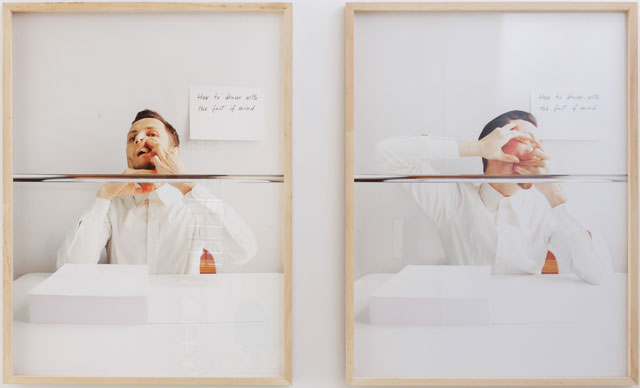
Alex Mirutziu, Between too soon and too late, 2018. Installation view, Delfina Foundation, London. Photograph: Tim Bowditch. Courtesy Delfina Foundation and European ArtEast Foundation.
IS: Are you always the protagonist of your work?
AM: Yes, I think I have to be. Another ongoing project of mine is titled, The Artist and Himself at 29. I decided to work with myself at 29 years old, to go back to a stage in my life that is no longer present. The age I chose has no particular relevance – it was just a way to go back in time. I made a series of masks cast from my own face at 29 – made first from plaster and graphite. I began to draw with them – like a strange mask-pen – drawing images of my own face.
IS: As with the desk, the mask-pen, you are the primary prism. What does this mean for Murdoch?
AM: I am thinking through her philosophy, the notion of the immaterial, inner life. Choosing the form for an idea is always difficult. I have a flow of ideas – but how to get them out my head? I constantly ask myself: what form? Should I draw it, perform it, write it? In the case of these sculptures, they came to me quickly: to crop the errors, then blow them up, to make them concrete. The rest of the works in the show were more complicated, and some of them depart from Iris entirely. Prepared Poem # 3 (2018), for example, is a poem that unfolds across a slanted magazine stand, each of the words at different sizes, and printed on transparent paper. It is somewhere between language, poetry and sculpture, and you can walk around the object, read it from many angles, find different fragments.
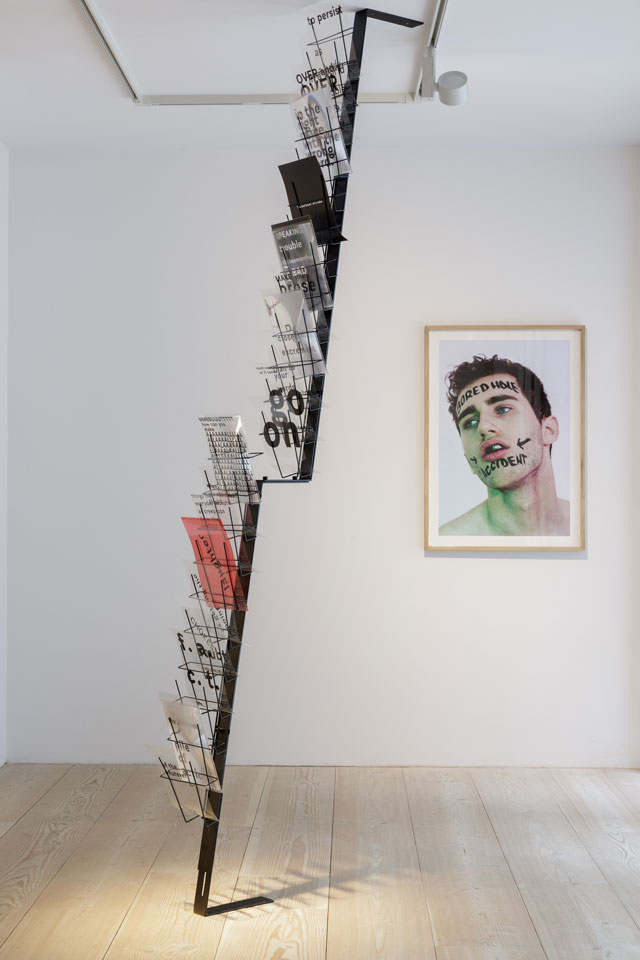
Alex Mirutziu, Prepared Poem # 3, 2018. Installation view, Delfina Foundation, London. Photograph: Tim Bowditch. Courtesy Delfina Foundation and European ArtEast Foundation.
I always go back to the idea of the writer at the desk, the ontological aspect of how you sit, draw, write. Even if the desk I have put in the exhibition is mine, I think about Iris at her desk, too. She wrote with a Parker pen, in longhand. Not any pen, the Parker pen. She was disciplined and she would sit for four hours a day to write letters. This is one reason why there are so many in the archive – she was a prolific letter writer.
IS: In Hilton Als’s White Girls (2013), he writes about the way in which, as a black gay man, he tends to identify with, or think through, the position of a white woman. He shows how these very different positions also contain intersections of privilege and oppression. In some ways, White Girls is about over-identification. I wonder: do you see your works about Murdoch containing a kind of over-identification, as you think through the position of a white woman – a white girl?
AM: There is a tendency to get too close, to get immersed. I am a Romanian man; she was a British woman, but it’s possible to see her struggles and my struggles. This over-identification – it happened. There is so much projection. I quote her, I remember something that she said – it feels significant. But I see her as a mirror. I come back to me, through her.
IS: Do you think about your archive? Who will look at it?
AM: I would be very careful about what I show, and I would try to impose a kind of control. I wouldn’t want to show sketches that are not finished, for example, nor would I want to show my notebooks. I will burn them all, if I can.